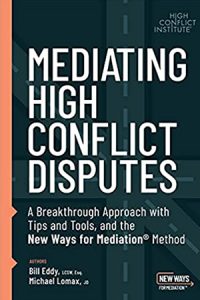BOOK REVIEW

Mediating High Conflict Disputes
A Breakthrough Approach with Tips and Tools and the New Ways for Mediation™ Method
Bill Eddy, LCSW, Esq. and Michael Lomax, JD
Unhooked Books, 2021
ISBN (print): 978-1950057214
ISBN (ebook): 978-1950057573
Library of Congress Control Number: 2021937936
Reviewed by: Heather Swartz, C.Med, M.S.W.
Bill Eddy is a profilic author and a well-known expert in techniques for working with clients with “high conflict” personality disorders or traits, individuals he refers to as High Conflict People (HCP). In collaboration with Michael Lomax, a fellow mediator and trainer, they have co-authored a clear and highly practical resource that summarizes the New Ways for Mediation™ Method refined and delivered at the High Conflict Institute.
Over the years I have been challenged by cases where one or more of the parties has demonstrated intense emotional outbursts and extreme behaviour; they blame others (their targets of blame) without taking any responsibility for their own contribution to the escalating conflict and get stuck in all or nothing thinking with an inflexible drive to “win.” In the first section of the book, the authors provide an understanding of the characteristics of HCPs and why it is important to avoid triggering defensiveness and, instead, to engage their logical brain when inviting them into a problem-solving mediation process. Most helpfully, the authors instruct conflict management practitioners on what not to do when working with HCPs. A combination of a lack of self-awareness, inability to change, and a pattern of externalizing responsibility means that efforts to help an HCP transform or gain insight can be interpreted by them as a personal attack by the mediator, putting the client and mediator into a non-productive attack and defend cycle. The authors suggest that asking an HCP to narrate their past in order to explore interests keeps them stuck in their emotions and the perspective that they are the victim of others.
The information in the first section provides an excellent foundation for The New Ways for Mediation™ Method descibed in step-by-step detail in the second and largest section of the book. In many instances, the advice of the authors and strategies are a sharp departure from what is generally practised when facilitating a traditional interest-based negotiation. In the New Way Method, clients are educated on a specific set of four skills and tasks (asking questions, making an agenda, making proposals, and making decisions). The authors indicate that empowering the clients with making joint process decisions, such as the agenda, increases their ownership in the process and reinforces the neutrality of the mediator. Keeping an HCP engaged with tasks and focused on the future requires a firm hold on the struture by the mediator, clear boundaries, and consistent guidance. The mediator’s educative role as a source of information is empahsized. The reader is reminded how crucial it is for the mediator to connect with an HCP and calm them using E.A.R. (Empathy, Attention, Respect), statements as descibed in this book and other books written by Bill Eddy.
Bill Eddy and Michael Lomax provide several practical examples and explore “what ifs” at each step of their four stage mediation process. A chapter on tips helps to differentiate this method from interest-based, therapeutic, transformative, or narrative models of mediation. While there is some repetition of concepts in the book and appendices, it reinforces the paradigm shift that a mediator trained in traditional methods needs to make. Without this reiteration, it would be very easy to fall back into asking the parties to make opening statements, exploring their feelings and using probing questions to discover parties’ interests. The authors provide sound reasons for a structure that limits emotional reactions and keeps clients focused on questions, proposals and decisions. They describe a “reverse interest-based negotiation” process where, after failed proposals, the mediator can identify interests based on previous proposals and ask the parties to generate new proposals. The book is infused with helpful scripts for every stage of the mediation process.
While reviewing this book, I was contracted to provide workplace restoration services subsequent to an investigation that found an allegation of harassment was unsubstantiated. During preliminary interviews, the complainant, demonstrated several traits of an HCP: had a series of interpersonal conflicts with the majority of their co-workers, was described by others as “inflexible” and “positional,” consistently affixed blame to others and particularly those in authority for not managing the workplace appropriately, repeatedly cycled back to negative emotions and descriptions of past incidents, resisted adopting any personal responsibility for problem-solving for the future. They stated they would not engage in a mediation with the respondent unless an apology was given.
In assessing the possible next steps for this workplace restoration, it was helpful for me to reflect on the authors’ explanation of “apology quicksand.” Eddy and Lomax describe the request for an apology by an HCP as a mechanism to dominate or humilate the other party and to absolve themselves of any responsibility. Despite a predisposition in favour of the power of apology between many disputants, based on the advice of the authors, I managed to avoid the quicksand in this case and, after an assessment of suitability, determined that mediation was not the best next step.
The authors generously impart their wisdom and experience in faciltating the resolution of conflict with HCPs. The third section of the book takes the tips and tools and applies them to a range of interventions with realistic examples of workplace mediation, divorce mediation, elder mediation, and large group facilitation. Practising mediators are given additional pointers in a chapter on ethical issues. Additional resources, including an outline of the New Ways for Mediation™ Method and role-play scenarios, are shared by the authors in several appendices.
This expanded description of applying the New Way method was helpful to me in a recent workplace coaching file. A manager was insistent that I “fix” the personality of a employee who had been “difficult” for the past twenty years and who constantly created conflict with management and colleagues. Given such unrealistic expectations, it was a challenge for me to shift the focus and coach the management team on how to work and communicate more effectively with an employee with high conflict traits. Rather than try to change the person, management decided to meet frequently with the employee for positive dialogue, to permit the employee to work alone more often, and to establish clear limits on conduct.
This practical and detailed book is of value to reflective practictioners, both new and experienced, as they adapt their thinking, approach and process to work effectively with individuals with high conflict traits.

Heather Swartz, C.Med, M.S.W.
Heather Swartz is a partner with Agree Incorporated. She has over two decades of workplace, family, and civil mediation experience. Her current practice focuses on workplace assessments and restorations. In 2017 Heather received the ADR Institute of Canada (ADRIC) Lionel J. McGowan Regional Award of Excellence.

